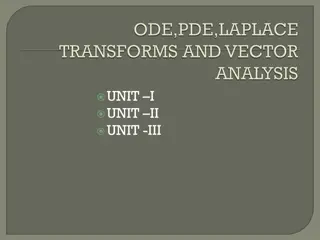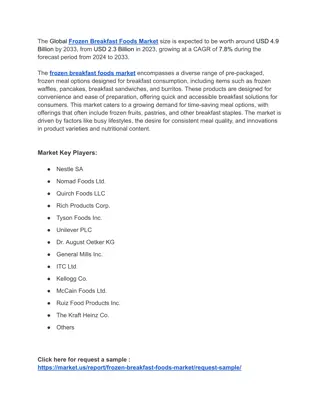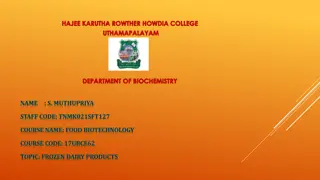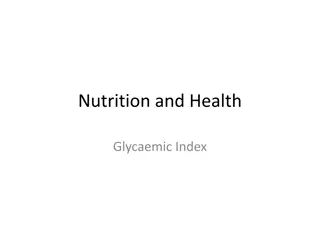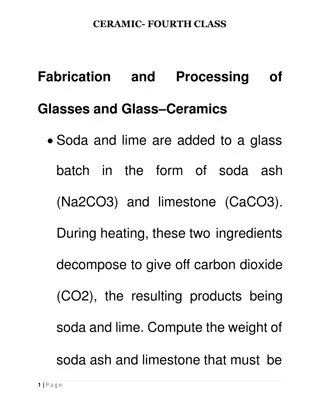Thermal Properties of Frozen Foods: Importance and Modeling Equations
Understanding the thermal properties of frozen foods is crucial for ensuring food safety and quality. Dr. J. Badshah discusses the significance of freezing, reduction of microorganism activity, and the role of thermal properties like density, specific heat, and thermal conductivity. Freezing point depression, nucleation rates, and ice crystal growth are also key factors considered in food freezing. This exploration provides insights into the thermodynamics of freezing, refrigeration requirements, and the design of freezers for maintaining the quality of frozen foods.
Download Presentation

Please find below an Image/Link to download the presentation.
The content on the website is provided AS IS for your information and personal use only. It may not be sold, licensed, or shared on other websites without obtaining consent from the author. Download presentation by click this link. If you encounter any issues during the download, it is possible that the publisher has removed the file from their server.
E N D
Presentation Transcript
Thermal Properties of Frozen Foods Dr. J. Badshah University Professor cum - Chief Scientist Dairy Engineering Department Sanjay Gandhi Institute of Dairy Science & Technology, Jagdeopath, Patna (Bihar Animal Sciences University, Patna)
Introduction Importance and Needs of modeling equation and tabulated values Density Specific Heat Thermal Conductivity Thermal Diffusivity Freezing Point Depression Thermodynamics of Food Freezing
Thermodynamics of Food Freezing Importance of of Foods and Freezing Reduction of the activity of microorganisms and enzymes\ Crystallization of water in Foods Physical and Thermal Properties of frozen Foods and their variations with temperature and concentration Refrigeration requirement or enthalpy change for freezing and prediction of freezing rates Rate of Refrigeration requiements, design of refrigeration system and Design of Freezers Quality of frozen foods & Rate of Nucleation and rate of ice crystal growth depends on properties and rate of freezing
Freezing Point Depresssion The actual or initial freezing point of water in the product will be depressed to some level below that expected for pure water due to dissolved solutes such as salts and carbohydrates directly and the components fat and protein depressed indirectly. The magnitude of this freezing point depression becomes a direct function of the molecular weight and concentration of the solute in the food product and in solution in the water. The expression or expression which predicts the extent of freezing point depression can be derived from thermodynamic relationships based on equilibrium between the states of a system. The final form is given by (Wb= molecular weight of component in solution, MB= mass in kg) Rgis gas constant Rg= w WA= 0.462 18 Rg= 8.316 Joules/moleoC WA= molecular weight of water = 18 moles/gm w = fraction of water
Freezing Point Depression The point at which the first ice crystal appears on cooling the liquid foods and the liquid is in equilibrium with solid ice is termed as initial freezing temperature. This temperature is always lesser than freezing temperature of pure water i.e. 0 C or 273 K as the food constitutes of solutes, freezable water and bound water. Bound water does not freeze even at very lower temperature such as 20 C. The mole fraction of freezable water or free water in food (Xw) is correlated with initial freezing temperature and latent heat of fusion by Heldman, in the following empirical equation: ( H/Rg){1/Two-1/Twf} =ln Xw Where, H = Latent heat of fusion =80 x18 calorie /mole or 80x18x4.1687 Joule/mole Rg= Gas constant= 1.987 calorie/mole K= 1.987x 4.1687 = 8.314 Joule/mole K Two= Freezing point of Pure water = 273 K and Twf= Freezing temperature of Food in respect of Xw -----------(1)
Freezing Point Depression The mole fraction of free water Xw= nw/(nw+ns) nw= Percent mass of free water /Molecular weight of water ns= (Percent mass of soluble solute/molecular weight of solute)+ (2 x Percent mass of salt/Molecular weight of salt) Per cent mass of free water = percent mass of total water- percent mass of bound water From equation (1), the freezing point depression can be derived as: ( H/Rg)[(Twf-Two)/TwoTwf] = ln ( 1 Xs) {as (Xw+ Xs) = 1} Considering Two Twf = Two2 {as Twf< Two} ( H/Rg)[(Twf-Two)/Two2] = ln ( 1 Xs) Where, Rg= 1.9872 cal/g mole K = 8.314 J/g mole K And ( H)= 80 x 18 cal/ mole = 80 X 4.16875 X 18 J/ g mol = 6003 Joule/mole
Freezing Point Depression If freezing point depression is (Two- Twf) i.e. Tf ( H/Rg)[ Tf/Two2] = - ln ( 1 Xs) (2) ( H/Rg)[ Tf/Two2] = Xs+1/2 Xs2+1/3 Xs Neglecting high power component as Xs <<<<<<1 H/Rg)[ Tf/Two2] = Xs As molality (m) of a solution is defined as mole fraction of solute per 1000 gram of solvent, it can be expressed as Molality m = {( fraction of ms/fraction of mw)x1000/ Molecular weight of solute Ms = Molecular weight of solute, ms= mass fraction of solute and mw = mass fraction of free water. Molality m = {(ms /Ms mw) x1000} (5) 3+------- (3) (4)
Freezing Point Depression Mole fraction of solute Xs = ns/ (ns +nw) As ns<<<< 1, neglecting it, Xs can be written as Xs= ns/ nw Xs= (ms/ Ms)/ (mw/Mw) =msMw/Msmw Therefore, ms/Msmw= Xs/ Mw Substituting this value in equation (4), we have: Molality m = (Xs/ Mw) x1000 Or Xs = m Mw/1000 Replace Xs in equation No. (4) ( H/Rg)[ Tf/Two2] = m Mw/1000 Tf = RgTwo2Mwm /1000 H Tf = [RgTwo2Mw/1000 H] m (6)
Freezing Point Depression Tf = (a constant ) m Where, m is molality and a constant is 1.86 for water, if Rgis 1.9872, Two is 273 K, Mwis 18 for water and H is 80x18 cal/g mole. In case of ice-cream mix preparation an example is considered here to calculate freezing point depression.
Numerical on Freezing Point Depression Ex.: Calculate the initial freezing point for the ice cream mixes of following composition: Butterfat =12%, SNF = 12%, Sucrose = 14% and stabilizer =0.25%.Assume lactose is 54.5% of SNF. Solution: Percent water = 100 (12 +12+14 +0.25) = 61.75 % The main solutes causing the depression in freezing point are sucrose and lactose, the fraction of which is calculated as follows: Fraction of solute= fraction of sucrose + fraction of lactose = 0.14 + 0.545 x 0.12 = 0.2054 g/g mixes Fraction of solute per 1000 g solvent = (0.2054/0.6175)x1000 Considering molecular weight of both sucrose and lactose as 342, the molality of mixes is calculated as: Molality m = = (0.2054/0.6175)x1000/342 =332.632/342 = 0.9726
Numerical contd Using the formula for freezing point depression from equation 6.0 : Tf = [RgTwo2Mw/1000 H] m Tf ={(1.9872 x (273)2x18)/(1000 x 80 x18)}x 0.9726 = 1.801 K 273 - Twf= 1.801 Initial Freezing Point = Twf= 271.199 K = - 1.801 C
Physical & Thermal Properties of Foods Density The influence of freezing on food product density is relatively small but a dramatic change does occur at and just below the initial freezing temperature. This change can be predicted by the following equation, as discussed by Heldman (2001): = 1/ ( m si / si ) Specific Heat The specific heat capacity of a food product can be predicted, based on product composition and the specific heat capacity of individual product components. The following expression was proposed: Cp = (C psi. m si ) where each factor on the right-side of the equation is the product of the mass fraction of a product component and the specific heat capacity of that component.
Physical and Thermal Properties..contd. These specific heat magnitudes for the product solids can be used in the prediction of product enthalpy and apparent specific heat. Cp= 4.180 Xw+ 1.711 Xp+ 1.98 Xf+ 1.547 Xc+ 0/908 Xa, ;kJ/kg0C .Cho s and Oko s Model Where, Xw: water fraction, Xp: Protein fraction Xf: Fat fraction, Xc:Carbohydrate fraction, XA:Ash fraction Thermal Conductivity Thermal conductivity ( ) is the intrinsic property of a material which relates its ability to conduct heat. Heat transfer by conduction involves transfer of energy within a material without any motion of the material as a whole. The thermal conductivity magnitudes of most food products are a function of water content and the physical structure of the product. Many models suggested for prediction of thermal conductivity are based on moisture content and orientation. do not consider structural
Thermal Propertiescontd. The Choi s and Oko s Model for prediction of thermal conductivity is as follows. K = 0.58 Xw+ 0.155 Xp+ 0.25 Xc+ 0.16 Xf+ 0.135 Xa ,W/m K .Cho s and Oko s Model Where, Xw: water fraction Xp: Protein fraction Xf: Fat fraction Xc:Carbohydrate fraction Xa:Ash fraction Thermal Diffusivity A measure of the rate at which a temperature disturbance at one point in a body travels to another point. It is expressed by the relationship K/ Cp, where K is the coefficient of thermal conductivity, is the density, and Cpis the specific heat at constant pressure.












